Letters from Lodi
An insightful and objective look at viticulture and winemaking from the Lodi
Appellation and the growers and vintners behind these crafts. Told from the
perspective of multi-award winning wine journalist, Randy Caparoso.
Why wine is tasted with your brain, not your palate
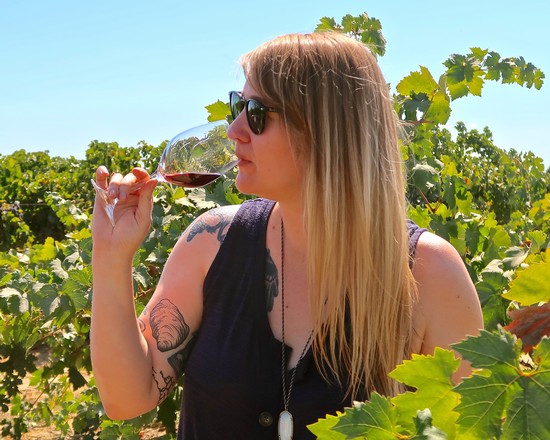
A sommelier making full use of her senses and brain to assess and enjoy a Zinfandel in the vineyard in which it was grown.
The Role of perception in Food and wine production
When you taste wine, are you using your eyes, nose, and mouth? Obviously, yes. However, there is plenty of evidence to suggest that you are not so much using sensory receptors as your actual brain because it's the brain that tells you how everything tastes. Your nose and mouth are simply the instruments used by your central nervous system to interpret sensations. This fact has a huge impact on how we perceive wines, and thus how wines are grown and made.
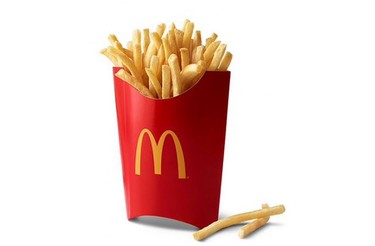
Why do these fries taste so good?
Consider this: In India, Hindu customers once marched in protest at a dozen locations of McDonald’s. In India, because of the dietary restrictions of the majority of the population, McDonald’s sells no beef products (only vegetable and lamb burgers). What raised the Hindus' ire? They had heard about a lawsuit in the U.S. brought by a group of vegetarians against McDonald's for flavoring their fries with a "natural flavor" derived from beef extract, which the Hindus were also unknowingly consuming (see The New York Times Archives on McDonald’s $10 million settlement of this issue with vegetarians and religious groups).
What is interesting about this is not so much that the actual percentage of beef extract in a super-sized package of fries reportedly amounted to just 0.000000000003%, but the fact that it was put into the fries precisely because the average person can perceive this flavor, even at infinitesimal levels. The Hindus were angry because McDonald’s was getting them to eat their fries by appealing to their raw, unconscious desire for beef — a thought planted in their heads, rather than an actual taste.
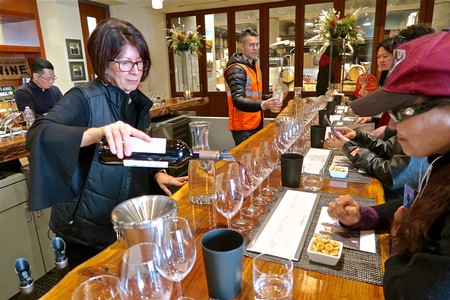
Wine tasting at Lodi's LangeTwins Family Winery.
Human beings may not have nearly as sensitive a nose as say, dogs and cats, but our perception of flavor is still a fine-tuned instrument. This makes us susceptible to manipulation by both the food and wine industries. In his landmark book Fast Food Nation, Eric Schlosser described "flavorists" — scientists who develop the minuscule chemical compounds used to flavor fast foods like McDonald's fries, and virtually all the processed foods consumed today — as "discreet, charming, cosmopolitan, and ironic." According to Schlosser, these are the sort of people "who not only enjoy fine wine but who can also tell you the chemicals that give each vintage its unique aroma."
Like Schlosser's flavorists, winemakers have long been aware of the fact that the aromas and flavors which distinguish, say, a Cabernet Sauvignon from a Merlot can be attributed to natural chemical compounds amounting to barely a few parts per trillion. The minty, often green or herbaceous character of Cabernet Sauvignon has been isolated to flavor components (grouped as methoxypyrazines) also found in bell peppers, which can easily be detected by an average person at approximately .02 parts per billion.
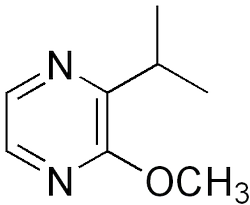
Chemical structure of isopropyl methoxy pyrazine (IPMP); i.e., the taste of "bell pepper."
Ask an oenologist what gives certain varietal reds such as Syrah, Petite Sirah, Zinfandel, and Grenache a characteristic peppery spice aroma, their answer would be rotundone, a sesquiterpene found in foods and wines clinically identified as (3S,5R,8S)-3,8-Dimethyl-5-(prop-1-en-2-yl)- 3,4,5,6,7,8-hexahydroazulen-1(2H)-one. But here is the curious thing about rotundone: In laboratory studies, it has been found that less than 25% of people can detect the presence of peppery qualities in wines. Zinfandel and Grenache may be defined by peppery spice, but for all intents and purposes, these qualities do not exist for a good proportion of wine consumers because it's usually below their threshold of perception. But for everyone else, a Syrah, Petite Sirah, Zinfandel, or Grenache can be very peppery, which are manifestations perceived by the brain.
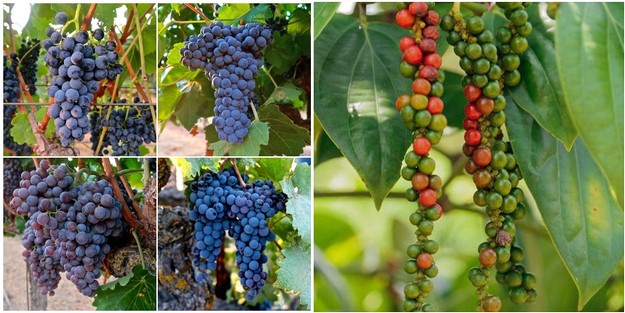
"Spice" grapes (from top left, clockwise, Syrah, Petite Sirah, Zinfandel, and Grenache) have varying degrees of rotundone, which is found in much higher proportions in black peppercorns (right).
"Chemistry set" Chardonnay production
Chardonnay is often described by the wine production industry as a tabula rasa or something of a "blank slate" that can be manipulated to attain specific tastes. A winemaker looking to maximize the appealing qualities that have made Chardonnay the best-selling white wine in America over the past thirty years tends to approach the varietal as something of an old-fashioned assembly, or chemistry, set: beginning by looking upon Chardonnay's varietal fruit profile more in terms of its basic chemical compound, ethyl-2-methyl butyrate, which gives off aromas suggesting green apple, the peel of apple or pineapple skin.
To further embellish the perception of ethyl-2-methyl butyrate, the vintner might put a Chardonnay through malolactic fermentation, and then barrel age it on its lees (i.e. spent yeast cells, which smell like the Saccharomyces cerevisiae used in bread baking). These practices also result in minuscule proportions of diacetyl or Butane-2,3-dione (which gives the taste of "butter") and 4-Hydroxy-3-methoxybenzaldehyde (the taste of “vanillin”), sometimes combined with methyl-2-pyridyl ketone (“popcorn” sensations). Hence, creamy, buttery, apple or tropical fruit-like sensations, plus a comforting smell akin to rising bread: voilà, a perfect replica of "California Chardonnay," or at least what many consumers associate with Chardonnay.
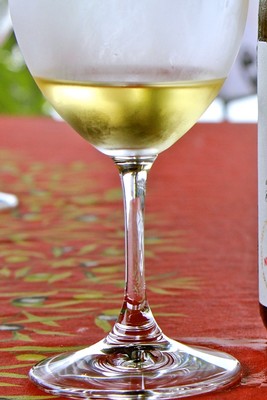
Classic golden straw color of Chardonnay, a tint traditionally derived from oxidation resulting from barrel aging.
Almost all commercial American Chardonnays sell for less than $16 or $18, however, never actually see the insides of a barrel. Oak barrels are very expensive, costing a minimum of $400 apiece; the finest barrels from France, anywhere from $900 to over $3,000. To bypass the cost, time, and labor demanded by barrels, value-priced Chardonnays are simply kept in stainless steel tanks, and oak chips bundled in food-grade mesh bags are dipped into the tanks for a few weeks (instead of months spent in barrels). Another "oak alternative" process is to utilize various sizes of oak staves, sticking them into tanks like bags of tea.
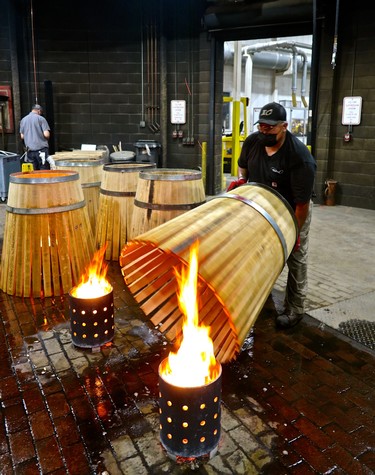
"Toasting" of oak over open fires, a process that enables wet staves to be bent into the traditional round shape of barrels.
To further duplicate the taste of an actual barrel, which attains its rounded shape by being bent over open flames resulting in charred or "toasted" surfaces, both chips and staves can be toasted over fires at varying degrees. Oak staves and chips, of course, are organic materials. If anything, the increasing usage of them has become a booming revenue source for the cooperage industry, which still commands access to oak mills and forests.
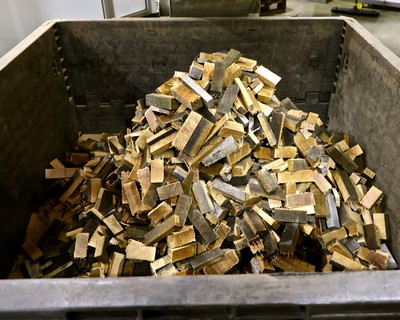
"Toasted" oak chips are used as a shortcut for duplicating the taste of wines aged in actual oak barrels.
More and more winemakers, however, are going in different directions, looking for less “butter,” “vanilla,” "toast" or fruity “apple/pineapple" flavors in their Chardonnay. Instead, many are prioritizing more of a “lemon” or citrus-related flavor profile; or, if they can get it, an elusive taste of minerals. Both lemony and mineral qualities can be pushed forward in the sensory perception when Chardonnays are made from earlier picked grapes that have less sugar and higher natural acidity (see Jordan Ross, Minerality, which addresses the relationship between acidity and mineral perceptions).
Why make an "opposite" style of Chardonnay? Because there is a growing segment of younger consumers (i.e., Millennials and Gen Zs born primarily after 1990) who are demonstrating a taste for wines that are lighter, leaner in fruitiness, and a little tarter rather than soft or buttery. A new generation of wine consumers looking for different Chardonnay profiles — is demanding a different usage of a winemaker's "chemistry set," so to speak.
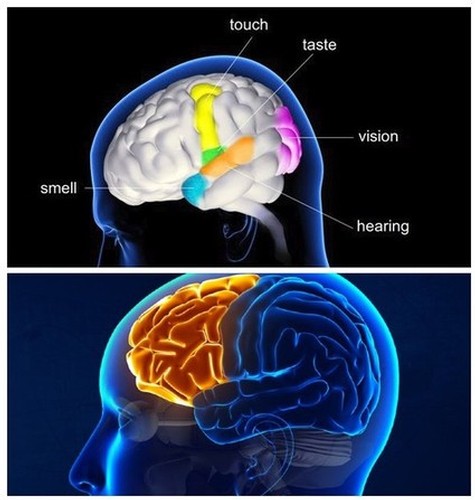
At the top, the temporal lobes of the central nervous system are utilized to distinguish tastes; and at the bottom, the cerebellum and prefrontal cortex are used to process the memories necessary for identifying sensations of smell, touch, taste, vision, and hearing.
How the brain functions as your operating system
Much of what we perceive as taste comes through our nose — as smells, rather than what is perceived through the mouth. Because the brain is so involved in how we distinguish both smells and sensations, it can be fooled by something as simple as visual impressions.
For instance, there was a 2003 paper published by Jeannine Frances Delwiche that demonstrated how the perception of a single, Chardonnay-based white wine was altered significantly simply by adding red or pink food coloring to the wines (see reference in Palate Press). When subjects saw a red-colored wine, they described it as being fuller-bodied than the white or pink wines. When they saw a pink-colored wine, they found it to be the fruitiest — even though they were tasting the exact same wine!
Even our taste buds, however, can be thrown by mixed signals sent to the brain. Each of the taste buds found in our tongues is composed of taste-receptor cells, commonly referred to as TRCs by researchers (see Nature, November 2006). TRCs are able to detect the five basic taste sensations, which most people know about the tastes of bitter, salty, sweet, sour, and umami.
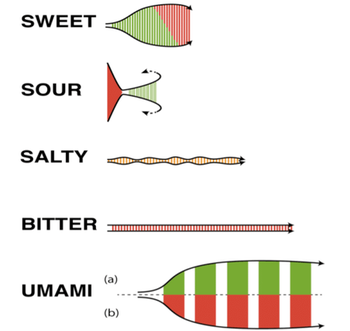
The characteristics of the five basic tastes: are the temporality shown through its length; affective reactions through the color (green pleasant, red unpleasant, orange neutral experience); and the embodiment through its form (mouth feeling). researchgate.net.
So when you taste something — be it a dish, or a beverage such as wine or coffee — each little sensation finds a dedicated TRC, which is label-lined along a neural path going directly to the brain for evaluation. Hence, when we eat ice cream, a glucose molecule comes into the mouth and fires up a TR2+TR1 receptor (which has cells wired primarily to detect sweetness); once that signal is sent and received by the brain, presto, your brain tells you “sweet,” while another part of the brain identifies it as "ice cream and still another registers it as "pleasure."
The interesting thing is that scientists have been able to modify cells in TR2+TR1 receptors to fire up only when, say, a bitter compound interacts with them. Result: Bitter compounds can also be made to taste sweet. In other words, it’s the cells that drive the perception of taste sensations, not the receptor itself.
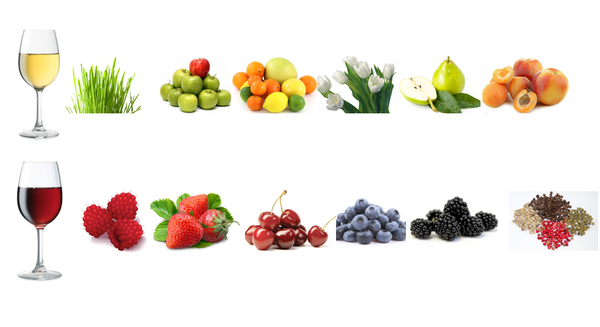
Some common fruit, plant, or spice aromas are often suggested to the brain's memory bank through the nose. afoodieworld.com.
The significance of that? Simply, our sense of taste is a physical apparatus involving connections between our brain, nose, and tongue; and whenever those connections are hot-wired, we can be made to taste things that are physically present in the most infinitesimal proportions, or not there at all. This is why the brain can be so easily confused or manipulated, the way flavorists can have us thinking “beef” when we are eating fries.
It is the brain, in fact, that distinguishes culinary talent. How many times have you heard it said that someone is a really good chef because they have a strong sense of taste? Or a winemaker is really good because he or she is an exceptional wine taster? In reality, what they have are minds that are better organized than that of most people. They have a knack for remembering sensations derived from ingredients and making delineations. Because of that, they are able to deftly manipulate those sensations with whatever technical skills and experience they bring to a kitchen or winery. It's the chefs and winemakers with the most prodigious brains who prepare the best dishes and make the best wines.
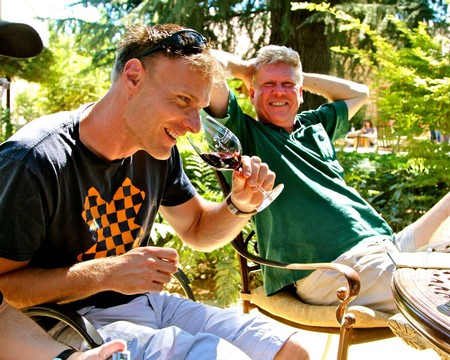
Two of Lodi's better-known winemakers (Markus Wine Co.'s Markus Niggli and m2's Layne Montgomery) — their talents derived from the efficient use of their minds as much as technical skills.
It is the same thing with accomplished wine tasters. Wine professionals, for instance, are not necessarily born with a sense of perception that is physically superior to that of the rest of the human race. It is purely because they make systematic use of their central nervous system. They study wine in order to fortify their memory bank, and thus are able to make more delineations when they taste them and speak with more clarity when communicating them.
This goes for everyone and anyone who appreciates wine, not just wine professionals. Whenever you make conscious use of your mind, your pleasure is bound to be increased simply on the basis of increased awareness. Wine appreciation is no different than any other aesthetic subject such as music or art, which becomes more comprehensible, more interesting, and more appealing whenever you understand the theory behind them or the lives and works of artists.
Fine wine physically tastes better whenever you apply your brain; and when that happens, you are actually getting more value for your money, whether you've spent $10 or several hundred dollars for a bottle.
Think about it!
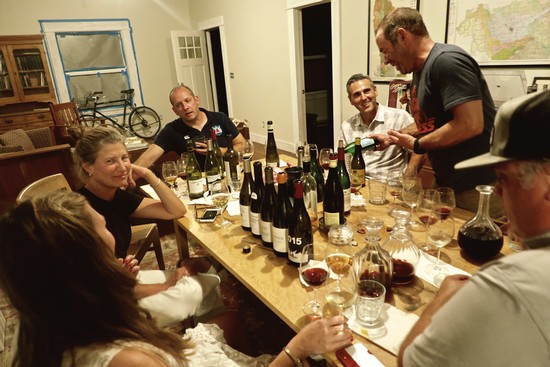
How seasoned wine industry professionals enjoy their products after hours (exactly like any other wine lover!).